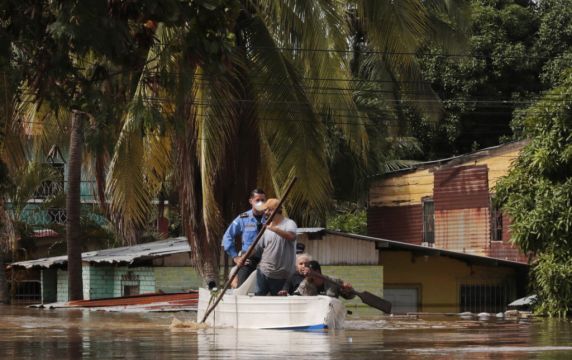Hurricane Iota has rapidly strengthened into a Category 5 storm that is likely to bring catastrophic damage to the same part of Central America already battered by Hurricane Eta less than two weeks ago.
Iota has intensified over the western Caribbean on approach to Nicaragua and Honduras.
US air force hurricane hunters flew into Iota’s core and measured maximum sustained winds of 160mph, the US National Hurricane Centre said.
Authorities warned that Iota would probably come ashore over areas where Eta’s torrential rains saturated the soil, leaving it prone to new landslides and floods, and that the storm surge could reach a shocking 12ft to 18ft (3.6 to 5.5 metres) above normal tides.

Evacuations were being conducted from low-lying areas in Nicaragua and Honduras near their shared border, which appeared to be the probable site of Iota’s landfall. Winds and rain were already being felt on the Nicaraguan coast on Sunday night.
Iota became a hurricane on Sunday and rapidly gained power. It became a dangerous Category 4 hurricane on Monday morning, and the US National Hurricane Centre warned it would probably reach the Central America mainland later on Monday.
It was already a record-breaking system, being the 30th named storm of this year’s extraordinarily busy Atlantic hurricane season.
Such activity has focused attention on climate change, which scientists say is causing wetter, stronger and more destructive storms.
In Honduras, compulsory evacuations began before the weekend and by Sunday evening 63,500 people were reported to be in 379 shelters just in the northern region, while the whole country was on high alert.
Nicaraguan officials said that by late Sunday afternoon about 1,500 people, nearly half of them children, had been evacuated from low-lying areas in the country’s north-east, including all the inhabitants of Cayo Misquitos. Authorities said 83,000 people in that region were in danger.

Wind and rain were beginning to be felt on Sunday night in Bilwi, a coastal Nicaraguan city where people crowded markets and stores during the day in search of plastic sheeting, nails and other materials to reinforce their homes, just as they did when Hurricane Eta hit on November 3.
Several residents of Bilwi expressed concerns that their homes would not stand up to Iota, so soon after Eta. Local television showed people being evacuated in wooden boats, carrying young children as well as dogs and chickens.
Authorities warned that the risk was high because Iota would probably come ashore over areas where Eta’s torrential rains left the soil saturated with water and more prone to new landslides and floods.
Eta hit Nicaragua as a Category 4 hurricane, killing at least 120 people as torrential rain caused flash floods and mudslides in parts of Central America and Mexico. Then it meandered across Cuba, the Florida Keys and around the Gulf of Mexico before slogging ashore again near Cedar Key, Florida, and dashing across Florida and the Carolinas.
Iota was forecast to drop up to 16 inches of rain in northern Nicaragua, Honduras, Guatemala and southern Belize, with as much as 30 inches in isolated spots. Costa Rica and Panama could also experience heavy rain and possible flooding, the hurricane centre said.
Eta was the 28th named storm of this year’s hurricane season, tying the 2005 record for named storms. Theta, the 29th, was far out in the eastern Atlantic Ocean, and became a remnant low on Sunday. The official end of hurricane season is November 30.







